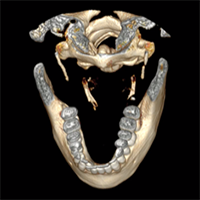 Smart Citations
Smart CitationsSee how this article has been cited at scite.ai
scite shows how a scientific paper has been cited by providing the context of the citation, a classification describing whether it supports, mentions, or contrasts the cited claim, and a label indicating in which section the citation was made.
The role of the styloid apophysis of the temporal bone in the biomechanics of the tongue, mandible, hyoid system: a case study
Temporomandibular disorders are characterized by ear pain, tinnitus, difficulty in chewing, dysphagia and also dizziness, cervical limitation of range of movement (ROM) and other less common disorders. Numerous recent studies associate the presence of these signs and symptoms with an elongated styloid apophysis, as in the case of Eagle syndrome. The purpose of this clinical case is to support the thesis of a common syndrome that temporomandibular joint (TMJ) disorders with an elongated styloid process affirming the relationship between temporal bone, mandibule, hyoid bone and tongue. The patient was a 57-year-old woman who reported having ear algia and tinnitus all on the right side with difficulty chewing accompanied by odynophagia and dysphagia of solid and liquid foods, as well as cervical disorders. Computed tomography (CT) scans of the neck showed elongation and ossification of the styloid processes of the temporal bone. Magnetic resonance imaging (MRI) showed an anterior right dislocation of the TMJ articular disc. The patient presented classic symptoms of temporomandibular disorders, with the primary examinations showing an anterior right dislocation of the articular disc of the TMJ, as well as a longer styloid process on the same side. We therefore suggested that, in this case report, TMJ disorders may be associated with a longer styloid process on the same side.
Downloads
How to Cite
PAGEPress has chosen to apply the Creative Commons Attribution NonCommercial 4.0 International License (CC BY-NC 4.0) to all manuscripts to be published.

 https://doi.org/10.4081/ejtm.2019.8808
https://doi.org/10.4081/ejtm.2019.8808





